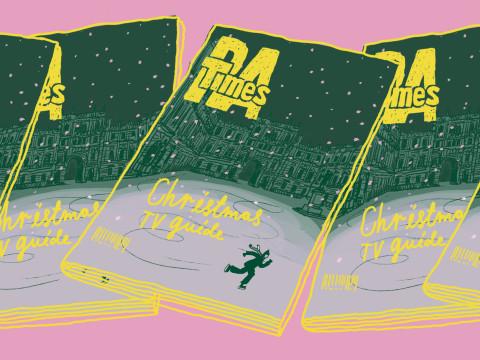
Dark arts: From Renaissance woodcuts to the Chapmans
By Eleanor Mills
Published on 28 October 2014
As Halloween looms, galleries across London and the UK are putting on exhibitions of a notably gothic nature.
The gothic has been inextricably linked with horror since Horace Walpole published his novel The Castle of Otranto in 1764. Set in a cursed medieval castle, Walpole’s gothic fiction tells of a family torn apart by love and death, while evil supernatural forces tinker with their fates.
Walpole popularised gothic through the novel and his own house, Strawberry Hill, a Gothic folly in south London. Through his examination of medieval architecture and an overactive imagination, Walpole formed some crucial associations that are linked to the word ‘gothic’ to this day: romanticising the past, with particular reference to medieval times and the architecture of castles and cathedrals; inexplicable or evil forces at play with humanity; the romance of melancholy, and a distinctly gloomy palette, or as Walpole elegantly termed it: ‘gloomth’.
These themes are picked up by a proliferation of gothic shows this autumn and winter.
Terror and Wonder: The Gothic Imagination
The British Library, London, until 20 January 2015
Beginning with Walpole’s novel The Castle of Otranto of 1764, this exhibition reveals its dark literary legacy through 250 pieces of art, books and objects. From a print after Henry Fuseli RA’s seminal gothic image The Nightmare (1783, above), Mary Shelley’s original manuscript of Frankenstein or The Modern Prometheus (1818) to the first edition of Bram Stoker’s Dracula (1897), right up to contemporary works by the Chapman Brothers.

Print made by Thomas Burke. London, 1783. On loan from the Trustees of the British Museum.
The Chapman Brothers
Fatal Consequences: The Chapman Brothers & Goya’s Disasters of War, Fitzwilliam Museum, Cambridge, until 8 February 2015
Jake and Dinos Chapman: In the Realm of the Unmentionable, Jerwood Gallery, Hastings, until 7 January 2015
The Chapman Brothers are famously fascinated with horror, particularly one of the highlights of the history of gothic art: Francisco Goya. The Fitzwilliam presents the Chapmans’ interpretation of Goya’s renowned Disasters of War print series, with added swastikas.
The Chapmans pursue their disfigurement of art at Jerwood Hastings, because, as brother Jake articulates, "working on someone else’s work optimises the idea that making art is a destructive rather than a creative act". They’ll be scouring Hastings town for material, which Jake thinks could provide, "a certain melancholic aesthetic to mess around with".

STÜCK HIRN BLIND: Jonas Burgert
BlainSouthern, London, until 22 November 2015
The grotesque visions of the Chapmans are echoed in Jonas Burgert’s paintings. Burgert uses a clever fusion of figuration and expressive brushwork in eye-wateringly bright colour, placing human protagonists into nightmarish situations. He aims to convey struggle through representing a collective subconscious: "There are two worlds we have, one is the one we see around us where we are convinced with the rules arranged for society and behaviour. And the other is in our mind, like a subtext, a different world, it’s a psychological scene". His biggest painting to date, stück hirn blind, portrays an impressively enigmatic narrative, leaving the viewer submerged in a fantastical post-apocalyptic world where tumult prevails.

Witches and Wicked Bodies
British Museum Room 90, London, until 11 January 2015
While Burgert’s Boschian scenes recall the turmoil of a bygone medieval era, the British Museum is hosting a display of prints that chronicles the depiction of witches from the 1400s to the end of the Victorian age. Thaumaturgical objects are shown alongside macabre images of hideous hags, like Hans Baldung Grien’s chiaroscuro woodcut The Witches’ Sabbath (1510, pictured at top), tracing the history of witches to their Pre-Raphaelite sexualisation in the work of Edward Burne-Jones and Dante Gabriel Rossetti.

Charles Stewart: Black and White Gothic
Tennant Gallery, Royal Academy of Arts, 20 December 2014 – 15 February 2015
Although it doesn't open until later this year, it's an appropriate moment to flag up our own forthcoming gothic-themed show.
Predating the Pre-Raphaelites somewhat, as well as Stoker’s Dracula, was a short gothic novel, Uncle Silas, written by Joseph Sheridan Le Fanu in 1864. Much like Walpole’s Otranto, written exactly a century earlier, the story takes place within the confines of a neglected mansion, and forces of the occult drive a naïve heiress to her peril.
This potent story haunted illustrator Charles Stewart (1915–2001) so much that he was compelled to make a series of 30 full-page, chilling pen and ink drawings to illustrate it, which go on display in the Tennant Gallery from December. If Susan Hill of The Woman in Black fame were to hire an illustrator now, Stewart would be the man for the job.

Eleanor Mills is Assistant Editor of RA Magazine.
Related articles

Art telly to watch this Christmas
11 December 2024

10 novels about art you won't put down
10 June 2022

Francis Bacon: "I'm always labelled with horror"
5 April 2022

Kawanabe Kyōsai: the demon with a brush
2 March 2022

13 things to know about Francis Bacon
14 February 2022
